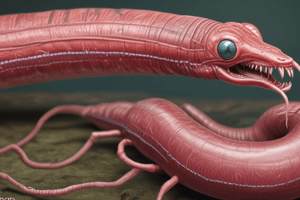Podcast
Questions and Answers
What is the significance of movement in living beings?
What is the significance of movement in living beings?
- It has no significant role in the life of living beings.
- It is a simple form of movement shown by unicellular organisms like Amoeba.
- It is only observed in animals and not in plants.
- It is a significant feature of living beings and can result in a change of place or location. (correct)
How are cilia and flagella involved in movement?
How are cilia and flagella involved in movement?
- They are only involved in locomotion but not in feeding.
- They are not involved in any kind of movement.
- They are only involved in feeding but not in locomotion.
- They are involved in the movement of food through cytopharynx and locomotion. (correct)
How can Hydra use its tentacles?
How can Hydra use its tentacles?
- Only for locomotion but not for capturing prey.
- Hydra does not use its tentacles for any purpose.
- For capturing prey and for locomotion. (correct)
- Only for capturing prey but not for locomotion.
How are movements and locomotion related?
How are movements and locomotion related?
How do the methods of locomotion vary among animals?
How do the methods of locomotion vary among animals?
Flashcards are hidden until you start studying
Study Notes
Significance of Movement in Living Beings
- Movement is essential for survival, enabling organisms to find food, evade predators, and reproduce.
- It allows for the interaction with the environment, facilitating adaptation and evolution.
- Movement can impact ecological relationships, influencing predator-prey dynamics and habitat selection.
Role of Cilia and Flagella in Movement
- Cilia are short, hair-like structures that beat in coordinated patterns to propel cells or move fluid over surfaces.
- Flagella are longer, whip-like structures that provide propulsion for single-celled organisms and some multicellular organisms.
- Both structures are composed of microtubules and are important for cellular locomotion, contributing to overall organism mobility.
Function of Hydra's Tentacles
- Hydra uses its tentacles to capture prey through stinging cells called nematocysts.
- Tentacles also aid in locomotion by anchoring the organism and facilitating movement across surfaces.
- Tentacles can be retracted or extended, allowing Hydra to maneuver effectively in its aquatic environment.
Relationship Between Movements and Locomotion
- Movement encompasses all physical activities of organisms, while locomotion specifically refers to movement from one place to another.
- Locomotion is a subset of movement, often involving specialized structures or mechanisms for transport.
- Effective locomotion can enhance a species’ ability to thrive in its habitat through better access to resources.
Variation of Locomotion Methods Among Animals
- Animals exhibit diverse locomotion strategies, including walking, swimming, flying, and gliding, adapted to their environments.
- Land animals may have limbs structured for running or climbing, while aquatic animals often use fins or streamlined bodies for efficient swimming.
- Some animals, like certain species of birds and insects, can switch between flight and ground movement to exploit different ecological niches.
Studying That Suits You
Use AI to generate personalized quizzes and flashcards to suit your learning preferences.




